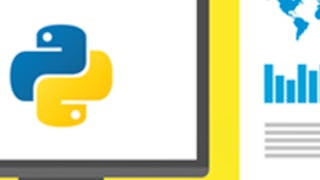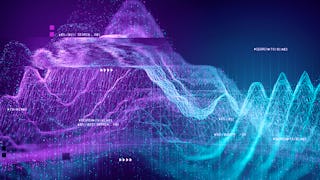Put the keystone in your Python Data Science skills by becoming proficient with Data Visualization and Modeling. This course is suited for intermediate programmers, who have some experience with NumPy and Pandas, that want to expand their skills for any career in data science. Whether you come to data science through social sciences and Statistics, or from a programming background, this course will integrate the two perspectives and offer unique insights from each.

Ends tomorrow. Heat up your career with 40% off courses from Adobe, IBM, and more. Save now.


Data Visualization and Modeling in Python
This course is part of Programming for Python Data Science: Principles to Practice Specialization



Instructors: Genevieve M. Lipp
Included with 
Recommended experience
Recommended experience
What you'll learn
Create professional visualizations for many kinds of data Utilize Classification algorithms to make predictions using a dataset
Skills you'll gain
Details to know

Add to your LinkedIn profile
4 assignments
See how employees at top companies are mastering in-demand skills

Build your subject-matter expertise
- Learn new concepts from industry experts
- Gain a foundational understanding of a subject or tool
- Develop job-relevant skills with hands-on projects
- Earn a shareable career certificate

There are 4 modules in this course
In this module, you will learn about plotting in Python—an important technique for exploring a dataset, and an indispensable tool for communicating insights. We’ll learn to make all the most common types of plots used in data science including the basics like line, bar, and scatter plots, as well as more advanced plot types including histograms and heatmaps. We’ll learn both how to make these plots and how they can be customized for your needs using a core plotting library for python, matplotlib, which serves as the backbone for many python plotting tools. You’ll learn how to create professional, accessible, and information-rich plots, which you will leverage to quickly identify trends in data that would be difficult to otherwise recognize. We've also included some optional additional readings if you want to further enhance your learning!
What's included
1 video30 readings1 assignment5 ungraded labs
This module, you will learn the basics of how to use code to make predictions based on data. After discussing what prediction is, you’ll learn to describe the concepts that underlie predictive algorithms within the context of the K-Nearest Neighbors (KNN) algorithm for both classification and regression. Additionally, you’ll learn to evaluate the accuracy of a predictive algorithm to assess its ability to generalize to new data. You will build your own KNN classification and regression algorithms from scratch and make predictions with each of them. At the end of this module, we’ll have a quiz to give you the opportunity to evaluate your understanding of predictive algorithms and reflect on your experience implementing your own.
What's included
1 video7 readings1 assignment5 ungraded labs
This module, you will learn how to describe the differences between prediction and inference, two key Data Science concepts. You’ll learn how to implement linear regressions — one of the most useful tools that data scientists have for inference and prediction — and other statistical models in Python. You’ll apply this knowledge by examining a dataset and regressing multiple variables on each other, and describing the insights on their relationships.
What's included
1 video7 readings1 assignment2 ungraded labs
This module, you’ll bring together the concepts and skills you’ve developed throughout the course to create a final project for your data science portfolio. You’ll recreate a now-famous data visualization that illustrates the relationship between the income of countries and their greenhouse gas emissions on a global scale. To do this, you’ll explore and prepare 4 datasets and merge them into a composite dataset that you’ll plot. Creating this merged dataset is an important step, and you’ll validate your merged dataset with a short quiz on the insights within. The end result of this effort will be a publication-quality plot that makes a compelling point about the relationship between emissions and income—an impactful visualization that showcases your growing programming skills for data science applications.
What's included
5 readings1 assignment7 ungraded labs
Earn a career certificate
Add this credential to your LinkedIn profile, resume, or CV. Share it on social media and in your performance review.
Instructors

Offered by
Explore more from Data Analysis
 Status: Free Trial
Status: Free Trial Status: Free Trial
Status: Free Trial Status: Free Trial
Status: Free Trial
Duke University
 Status: Free Trial
Status: Free Trial
Why people choose Coursera for their career





Open new doors with Coursera Plus
Unlimited access to 10,000+ world-class courses, hands-on projects, and job-ready certificate programs - all included in your subscription
Advance your career with an online degree
Earn a degree from world-class universities - 100% online
Join over 3,400 global companies that choose Coursera for Business
Upskill your employees to excel in the digital economy
Frequently asked questions
Access to lectures and assignments depends on your type of enrollment. If you take a course in audit mode, you will be able to see most course materials for free. To access graded assignments and to earn a Certificate, you will need to purchase the Certificate experience, during or after your audit. If you don't see the audit option:
The course may not offer an audit option. You can try a Free Trial instead, or apply for Financial Aid.
The course may offer 'Full Course, No Certificate' instead. This option lets you see all course materials, submit required assessments, and get a final grade. This also means that you will not be able to purchase a Certificate experience.
When you enroll in the course, you get access to all of the courses in the Specialization, and you earn a certificate when you complete the work. Your electronic Certificate will be added to your Accomplishments page - from there, you can print your Certificate or add it to your LinkedIn profile. If you only want to read and view the course content, you can audit the course for free.
If you subscribed, you get a 7-day free trial during which you can cancel at no penalty. After that, we don’t give refunds, but you can cancel your subscription at any time. See our full refund policy.
More questions
Financial aid available,





